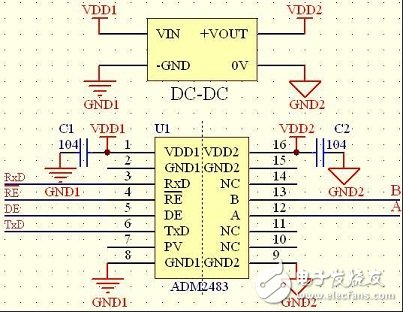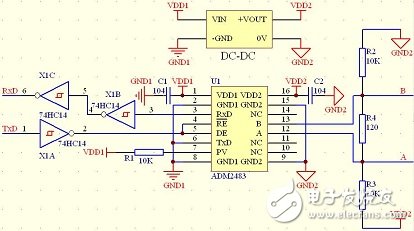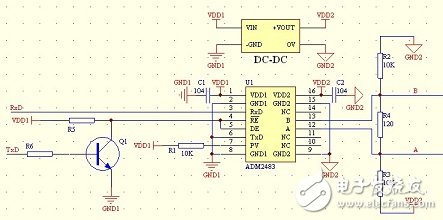The RS-485 standard is widely used in industrial control, power communication, and smart meters. However, in the field environment such as industrial control, the situation is complicated, and there are often electrical noises that interfere with the transmission line. When multiple systems are interconnected, there will be potential differences between the grounds of different systems, forming a ground loop that will interfere with the entire system. It can cause catastrophic damage to the system; there may also be high voltages or large currents such as potential current surges that damage equipment or endanger people. Therefore, isolation of the RS-485 interface is very necessary.
Isolated RS-485 interface circuit
The 485 interface isolation circuit we often use is to use three optocouplers to isolate the transceiver and control signals. In addition, the 485 transceiver requires a total of 4 ICs, and the optocoupler isolation requires current limiting and output pull-up resistors. If necessary, it will also be used. Transistor drive. The design circuit is cumbersome and takes a long time. If there is no previous experience in optocoupler, it will take a lot of unnecessary time in optocoupler current limiting and output pull-up resistor; and the optocoupler output signal rises for a long time. When connected to the digital I/O port, Schmitt shaping is required to ensure that the waveform of the signal conforms to the standard, such as in FPGA, DSP and other systems.
The ADM2483 is a chip with integrated magnetic isolation channel and 485 transceiver. The integrated magnetic isolation channel principle is different from that of optocoupler. There are code decoding circuit and Schmitt shaping circuit at the input and output terminals to ensure the quality of the output waveform. The magnetic isolation power consumption is only 1/10 of the optocoupler, and the transmission delay is ns. The transmission from DC to high-speed signals has the performance advantage over the optocoupler. An integrated low-power 485 transceiver with a signal transfer rate of up to 500Kbps and a back-end bus capable of supporting 256 nodes. With true fail-safe, power monitoring and thermal shutdown.
To achieve a circuit design that isolates the RS-485 interface, simply connect a 104 decoupling capacitor between the ADM2483's power supply and ground. Of course, DC-DC isolated power is essential. The circuit is connected as shown below:

Signal self-transmission circuit
Signal self-transmission circuit We use 74HC14 chip, use its Schmitt waveform flipping performance to control RE, DE pin, to achieve signal self-transmission. The circuit is connected as shown below:

As shown in the figure, the MCU's transmit signal is inverted by the Schmitt trigger and then sent to the DE and RE pins, and the transmit data pin TxD is grounded.
When there is a high level signal transmission, the DE/RE pin input is low level after the reverse direction becomes a low level signal, so that the transmission driver is disabled and the bus is in a high impedance state. At this time, the bus on the A and B lines The pull-up resistor produces a high level output. When a low-level signal is sent, the DE/RE pin is input to a high level after the reverse signal is turned high, so that the transmit driver operates, and the TxD pin is grounded, and is low. A low level is sent to the bus.
Only the self-transmission function of the RS-485 interface is implemented. In practical applications, corresponding modifications should be made according to the usage. The transceiver circuit also has disadvantages. When the high level is continuously transmitted, the DE/RE pin of the ADM2483 is in the receiving state. Therefore, both the transmitting end and the receiving end are in the receiving state, and the bus is idle. It is to allow each node to send data, so this method is generally adopted in the master-slave network structure. There are also several different schemes for implementing RS-485 transceiver self-transmission on the network, respectively:
Using the reverse principle of triode
The circuit is as follows:

When no data is transmitted, the TxD signal is high, and the ADM2483 is in the receiving state after V1 is inverted. When the data is transmitted, when TxD is high, the V1 is reversed, the transmission driver is disabled, and the bus is in a high-impedance state. At this time, a high-level output is generated by the pull-up resistors on the A and B buses. When TxD is low, the V1 is reversed to make the transmit driver work. Because the TxD pin is grounded, it is low, thus sending a low level to the bus.
KNM5 Series Moulded Case Circuit Breaker
KNM5 series Moulded Case Circuit Breaker is MCCB , How to select good Molded Case Circuit Breaker suppliers? Korlen electric is your first choice. All moulded Case Circuit Breakers pass the CE.CB.SEMKO.SIRIM etc. Certificates.
Moulded Case Circuit Breaker /MCCB can be used to distribute electric power and protect power equipment against overload and short-current, and can change the circuit and start motor infrequently. The application of Moulded Case Circuit Breaker /MCCB is industrial.
Korlen electric also provide Miniature Circuit Breaker /MCB. Residual Current Circuit Breaker /RCCB. RCBO. Led light and so on .
KNM5 series Molded Case Circuit Breaker,Small Size Molded Case Circuit Breaker,Electrical Molded Case Circuit Breaker,Automatic Molded Case Circuit Breaker
Wenzhou Korlen Electric Appliances Co., Ltd. , https://www.zjmoldedcasecircuitbreaker.com
